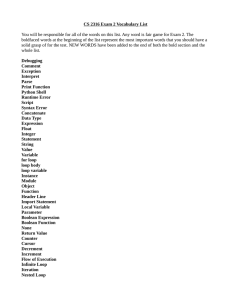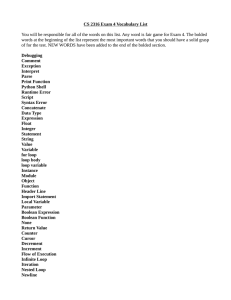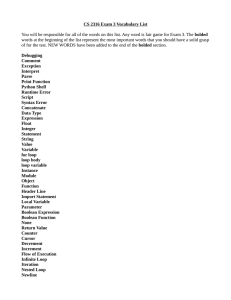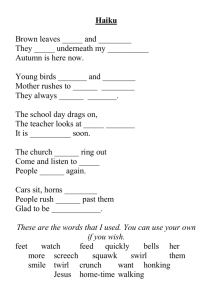Basic Programming Vocabulary
advertisement
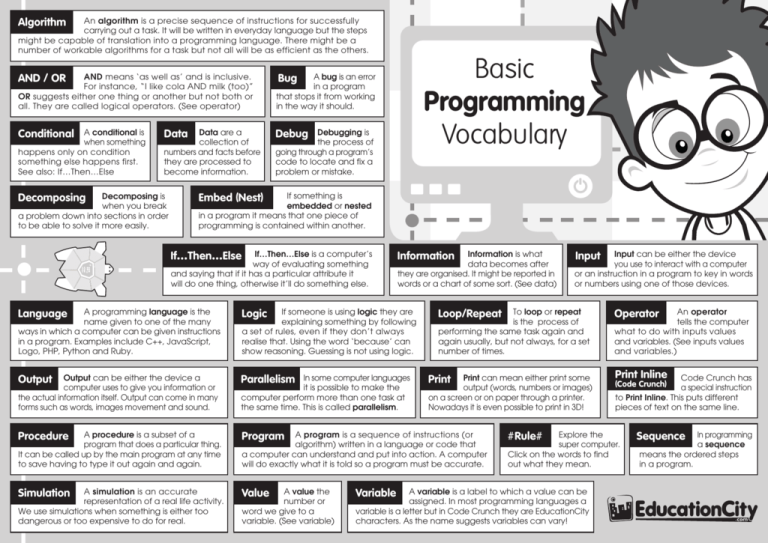
An algorithm is a precise sequence of instructions for successfully carrying out a task. It will be written in everyday language but the steps might be capable of translation into a programming language. There might be a number of workable algorithms for a task but not all will be as efficient as the others. Algorithm AND means ‘as well as’ and is inclusive. For instance, “I like cola AND milk (too)” OR suggests either one thing or another but not both or all. They are called logical operators. (See operator) A bug is an error in a program that stops it from working in the way it should. A conditional is when something happens only on condition something else happens first. See also: If…Then…Else Debug AND / OR Conditional Data are a collection of numbers and facts before they are processed to become information. Data Decomposing is when you break a problem down into sections in order to be able to solve it more easily. Decomposing Debugging is the process of going through a program’s code to locate and fix a problem or mistake. Embed (Nest) If something is embedded or nested in a program it means that one piece of programming is contained within another. If…Then…Else is a computer’s way of evaluating something and saying that if it has a particular attribute it will do one thing, otherwise it’ll do something else. If…Then…Else Language A programming language is the name given to one of the many ways in which a computer can be given instructions in a program. Examples include C++, JavaScript, Logo, PHP, Python and Ruby. Logic Output Output can be either the device a computer uses to give you information or the actual information itself. Output can come in many forms such as words, images movement and sound. Parallelism Procedure A procedure is a subset of a program that does a particular thing. It can be called up by the main program at any time to save having to type it out again and again. Program A simulation is an accurate representation of a real life activity. We use simulations when something is either too dangerous or too expensive to do for real. Value Simulation Basic Programming Vocabulary Bug Information is what data becomes after they are organised. It might be reported in words or a chart of some sort. (See data) Information If someone is using logic they are explaining something by following a set of rules, even if they don’t always realise that. Using the word ‘because’ can show reasoning. Guessing is not using logic. In some computer languages it is possible to make the computer perform more than one task at the same time. This is called parallelism. To loop or repeat is the process of performing the same task again and again usually, but not always, for a set number of times. Loop/Repeat Print can mean either print some output (words, numbers or images) on a screen or on paper through a printer. Nowadays it is even possible to print in 3D! Print A program is a sequence of instructions (or algorithm) written in a language or code that a computer can understand and put into action. A computer will do exactly what it is told so a program must be accurate. A value the number or word we give to a variable. (See variable) Input can be either the device you use to interact with a computer or an instruction in a program to key in words or numbers using one of those devices. Input #Rule# Print Inline Code Crunch has a special instruction to Print Inline. This puts different pieces of text on the same line. (Code Crunch) Explore the super computer. Click on the words to find out what they mean. A variable is a label to which a value can be assigned. In most programming languages a variable is a letter but in Code Crunch they are EducationCity characters. As the name suggests variables can vary! Variable An operator tells the computer what to do with inputs values and variables. (See inputs values and variables.) Operator Sequence In programming a sequence means the ordered steps in a program.
